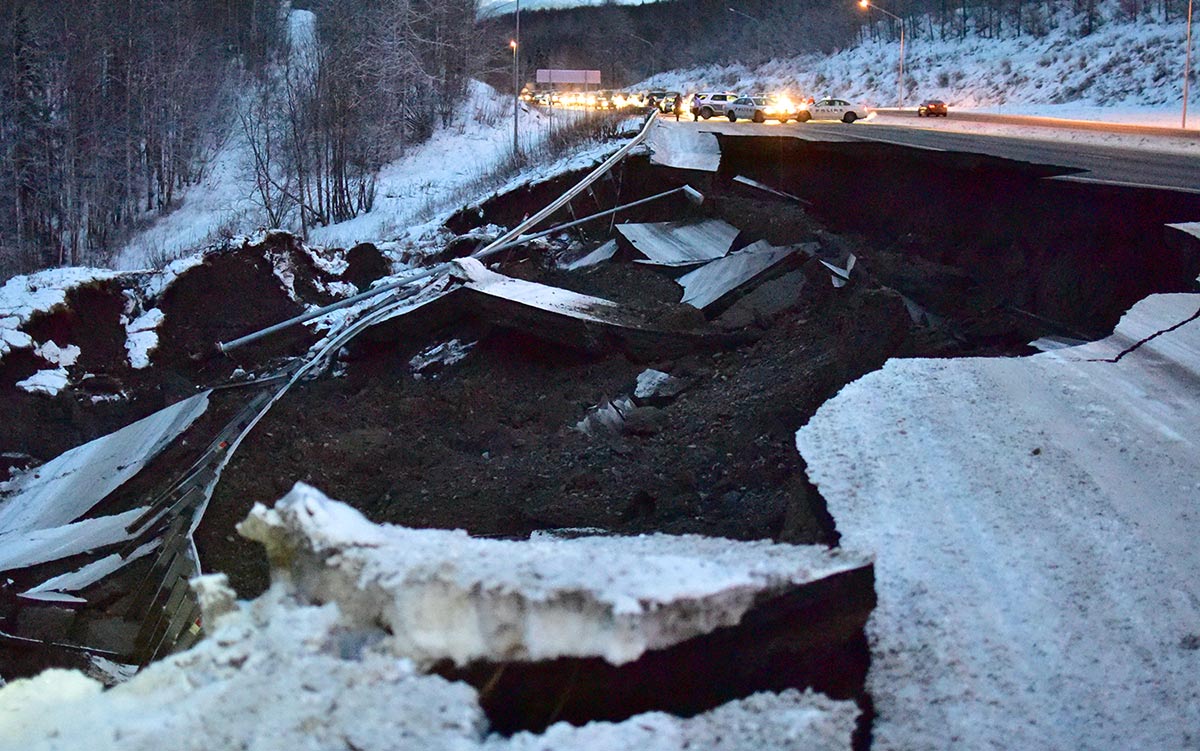
t approximately 8:30 a.m., on Nov. 30, 2018, things got a bit shaky in Anchorage, Alaska. A massive 7.1 magnitude earthquake hit just 10 miles north of the city. More than 6,000 aftershocks would affect this area within weeks, many of which were calculated at a magnitude of 4 or higher.
After the initial shocks had subsided (pun intended), I, along with others, quickly learned about civil engineering, specifically geotechnical engineering. This was because our properties or work locations were damaged and in need of investigation and repair.
Today, I find myself reflecting upon the damage the earthquake caused to our local businesses and drawing some parallels to leadership. I call it “geotech leadership.”
Just like geotechnical engineering, geotech leadership includes the investigation of subsurface issues and the identification of a proper foundation. It includes the analysis and evaluation of a variety of environmental factors and probable outcomes. Finally, it includes recognizing and executing mitigation activities.
Geotech leadership isn’t difficult, but it does require purposeful investment.
Supporting the structure which rests on it, a building’s foundation helps to secure it to the ground and helps to transfer or distribute the weight/load. Much like a geotechnical engineer, the geotech leader needs to assess business or team objectives to better identify what foundation can appropriately support the expected load.
To illustrate this concept, consider a business that is relatively new. We can assume the initial team needs to have a foundation of technical competencies such as basic job knowledge, skill proficiency and business acumen. Behavioral competencies such as communication, service and professionalism could also be included. Tools such as computers, software applications, and the capability to collaborate may also be necessary parts of the foundation.
Nearly every decent manager would ensure the above foundation, albeit shallow, is present. But a geotech leader would consider other factors, such as anticipated growth, accelerated need for learning, or potential partnerships and alliances. In other words, the geotech leader would consider a host of other things and, subsequently, identify if there was a need for a deeper foundation. The geotech leader might ask, “given what we expect, what type of foundation is needed?” In this case, the geotech leader might actively recruit someone with expertise in analyzing business development activities and formulating sound partnerships. They might fill their initial team with individuals who have more than just basic communication competencies such as the capacity to speak, engage, interpret and actively listen. The geotech leader might, because they foresee a diverse and dispersed workforce, invest in advanced collaborative and conferencing tools and ensure his workforce has the ability, willingness and interest in utilizing these tools to their full potential.
In summary, the geotech leader does a thorough job analyzing both the current and future environment when building their foundation. This ensures that future growth, productivity, quality, etc. is not hindered by weak footings.
Just as geotechnical engineers evaluate the stability of natural slopes and irrigation, man-made factors and deposits, site use, etc., geotech leaders must thoroughly assess both external and internal environmental factors. I have discovered that too few leaders proactively assess these conditions outside of the boardroom or outside of their strategic planning activities. Too few leaders take their leadership to the geotech level.
Geotech leaders evaluate the macro-environmental factors that affect their business environment. For instance, they might consider the PESTEL model.
- Political Factors
These determine the extent to which government and government policy may impact a business or industry and would include political policy and stability as well as trade, fiscal and taxation. - Economic Factors
Issues such as interest rates, employment or unemployment rates, raw material costs and foreign exchange rates directly impact a business and its profitability. - Social Factors
These factors, which include changing family demographics, education levels, cultural trends, attitude changes, lifestyle changes, etc., have a direct impact on the customer and market needs. - Technological Factors
Digital and mobile technology, automation, artificial intelligence, research and development are examples of technological factors affecting a market or industry. - Environmental Factors
Issues such as climate, carbon footprint, waste disposal, recycling efforts and sustainability are influencing modern business. They are especially critical to a business appreciating and wanting to improve its corporate sustainability responsibility. - Legal Factors
Employment legislation, consumer law, health and safety, international/trade regulation and restrictions are all examples of legal factors that impact business operations.
Geotech leaders also consider things like Porter’s Five Forces, which is the framework that helps analyze the level of competition within a certain industry. I find this model, which showcases the following five forces, especially useful when helping a new business or re-evaluating or redefining an existing business.
- Threat of New Entrants
New entrants in an industry bring new capacity and the desire to gain market share. The seriousness of the threat depends on the barriers to enter. The higher these barriers to entry, the smaller the threat for existing players. - Bargaining Power of Suppliers
This force analyzes how much power and control a company’s supplier has over the potential to raise its prices or reduce the quality of purchased goods or services, which could lower an industry’s profitability potential. - Bargaining Power of Buyers
This force analyzes the extent to which customers can put the supplier under pressure. Buying power is high when there aren’t many customers or when customers have many alternatives to buy from. Buying power is low when customers purchase products in small amounts, act independently or when the seller’s product is unique. - Threat of Substitute Products or Services
The existence of products outside of the realm of the common product boundaries increases the propensity of customers to switch to alternatives. - Existing Industry Rivalry
The number of existing competitors and what each competitor is capable of doing determines the intensity of current competition in the marketplace. Rivalry is high when there are a lot of competitors that are roughly equal in size and power, when the industry is growing slowly or when consumers can easily switch to a competitor with little to no disruption in their own operations.
As much as geotechnical and civil engineers would like to believe that their physical structures can withstand the test of time, the fact is the structure can be perfect and still deteriorate. Internal factors such as plumbing, electrical systems, and proper use of the structure’s internal components all have a significant impact on its long-term strength and sustainability.
So goes a business. Thus, geotech leaders consistently evaluate a variety of internal factors too!
- Value System
The value system includes the ethical beliefs that guide the business in achieving its mission and objectives. The value system also determines the workforce’s behavior toward each other, customers and other stakeholders. The value system must be actively demonstrated. Published-but-not-demonstrated values erode trust. - Mission and Objectives
The business’s mission is defined as the overall purpose or reason for its existence, which guides and influences its business decisions and economic activities. Its objectives are the milestones or outcomes that slowly but surely move the business forward. Alignment between mission and objectives is critical. - Structure and Governance
This includes things such as the composition of board of directors and leadership teams, the autonomy of management, etc. These issues have significant influence over decision making, adaptability and growth, and if they are complex, bureaucratic or unreasonable, success will often elude the business.

- Policies and Protocols
These are about the operational side of the business and describe how rules, protocols and standards are executed and measured. Wages, working conditions, efficiencies and performance are some examples, but also included in these factors are initiatives regarding quality, improvement and compliance. Consistency, fairness, reasonableness and clarity are needed to ensure the health, productivity and quality of a business. - Corporate Culture
Corporate culture is an important factor for determining the health of a business. While it is possible to have an organic or grassroots change to culture, a leader or team of leaders generally sets the stage for corporate culture. Ideally, it should be open and participatory, not closed or threatening. - Quality of Employees/Human Resources
The quality of employees is an important factor, as the success of the business relies to a great extent on the skills, capabilities, attitudes and commitment of its workforce. - Physical Resources and Capabilities
Facilities, equipment, tools and technology determine a business’s efficiency, productivity and attractiveness to the workforce. Research and development capabilities determine its ability to introduce innovations, which enhance productivity, quality and performance.
Just like their engineering counterparts do, geotech leaders consistently investigate and evaluate the strength or vulnerabilities of both external and internal factors that ultimately affect the sustainability of their structure, product or, in this case, their business and team.
Geotechnical engineers formulate approaches to manage the risk of harm or damage to their structures. For instance, they may suggest enhanced or redesigned landscaping to help with irrigation, or they may suggest a specific drainage system to irrigate subsurface water away from the foundation.
Likewise, geotech leaders execute mitigating activities to increase the team’s probability of success and sustainability. This might include halting a business initiative mid-stream to encourage progress on a parallel goal, or it might include removing a toxic individual to salvage the health of a team. It might include investing in something new or retreating to a historical, but safe and effective, practice. Ultimately, the geotech leader continually scans the environment and solicits ideas for continued or improved efficiencies, productivity, profitability, quality and satisfaction.
- Rome wasn’t built in a day, nor was it the brainchild of a sole engineer.
- Both ancient and modern factors have eroded the awesome Egyptian pyramids, not because they were poorly built but because their future wasn’t fully anticipated.
- The wondrous Taj Mahal is deteriorating, not because of faulty engineering but because of continued neglect and superficial mitigation efforts.
What I can infer from those facts is this:
- Geotech leaders work collaboratively with a diverse group of stakeholders to identify and lay a foundation that can support future expectations.
- Geotech leaders commit to consistent investigation and evaluation of both external and internal factors of the business environment.
- Geotech leaders prioritize mitigating activities that address subsurface problems and challenges.
The November 30th earthquake rattled many Alaskans. And while the aftershocks continue to come and are increasingly unnerving, I trust our geotechnical engineers are working hard to ensure our city can handle the next big shake.
Businesses get shook up quite a bit, too. There are some massive disruptors, such as significant fluctuations in our economy, mergers and acquisitions, bankruptcy, etc. And while the numerous reverberations are unpredictable and incredibly stressful, I trust our geotech leaders will have done their due diligence to ensure the workforce can handle the next big thing.

Heather Kinzie, SHRM-SCP, serves as the Chief Operating Officer for The STRIVE Group. With more than 20 years of organizational and workforce performance experience, Kinzie offers consulting, coaching, content development and training to clients. She oversees a team of experts who utilize a broad, systematic approach to problem solving and consultation. Recognizing the critical importance of leadership, communication and effective collaboration among teams, Kinzie is committed to helping clients improve communication, engagement and organizational performance.
Heather Kinzie, SHRM-SCP, serves as the Chief Operating Officer for The STRIVE Group. With more than 20 years of organizational and workforce performance experience, Kinzie offers consulting, coaching, content development and training to clients. She oversees a team of experts who utilize a broad, systematic approach to problem solving and consultation. Recognizing the critical importance of leadership, communication and effective collaboration among teams, Kinzie is committed to helping clients improve communication, engagement and organizational performance.